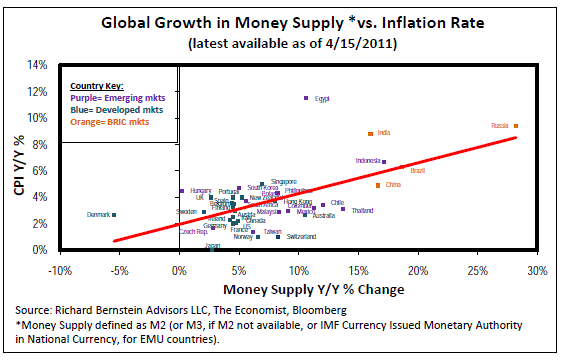Investors in the USA are still excessively concerned about the expanding money supply. The usual argument has something to do with the always scary sounding “debt monetization“, “money printing” due to QE and other mythical forms of money supply expansion which are repeated on a daily basis by people who are more interested in scaring you than providing sound research about the actual workings of our monetary system (see here for more on this).
There is, however, a region of the world where these concerns are legitimate. In a recent research note Richard Bernstein of Richard Bernstein Advisors discussed this misconception and how it is the emerging markets that are most at risk of high inflation due to excessive “money printing”:
“There is a gross misperception among many investors that “printing money” (using the current phrase for monetary stimulus) causes inflation. That is not quite the relationship outlined in economic textbooks. Monetary theory does not state that printing money alone causes inflation. Rather, it says that printing money and doing something with it causes inflation. That “doing something” is commonly referred to as credit creation.
It is interesting that investors are very worried about inflation in the US, where credit growth is moribund, but they are not particularly worried about inflation in the major emerging markets where credit growth has been rapidly growing. Emerging-market investors like to use the term “overheating” to describe those markets, but few point out that overheating (i.e., demand greater than supply) typically occurs in late-cycle economies.
Chart 2 highlights the current relationships between monetary growth and inflation. The BRIC’s extreme monetary growth has clearly contributed to the world’s highest inflation rates.”

Source: RBA
Mr. Roche is the Founder and Chief Investment Officer of Discipline Funds.Discipline Funds is a low fee financial advisory firm with a focus on helping people be more disciplined with their finances.
He is also the author of Pragmatic Capitalism: What Every Investor Needs to Understand About Money and Finance, Understanding the Modern Monetary System and Understanding Modern Portfolio Construction.

Comments are closed.